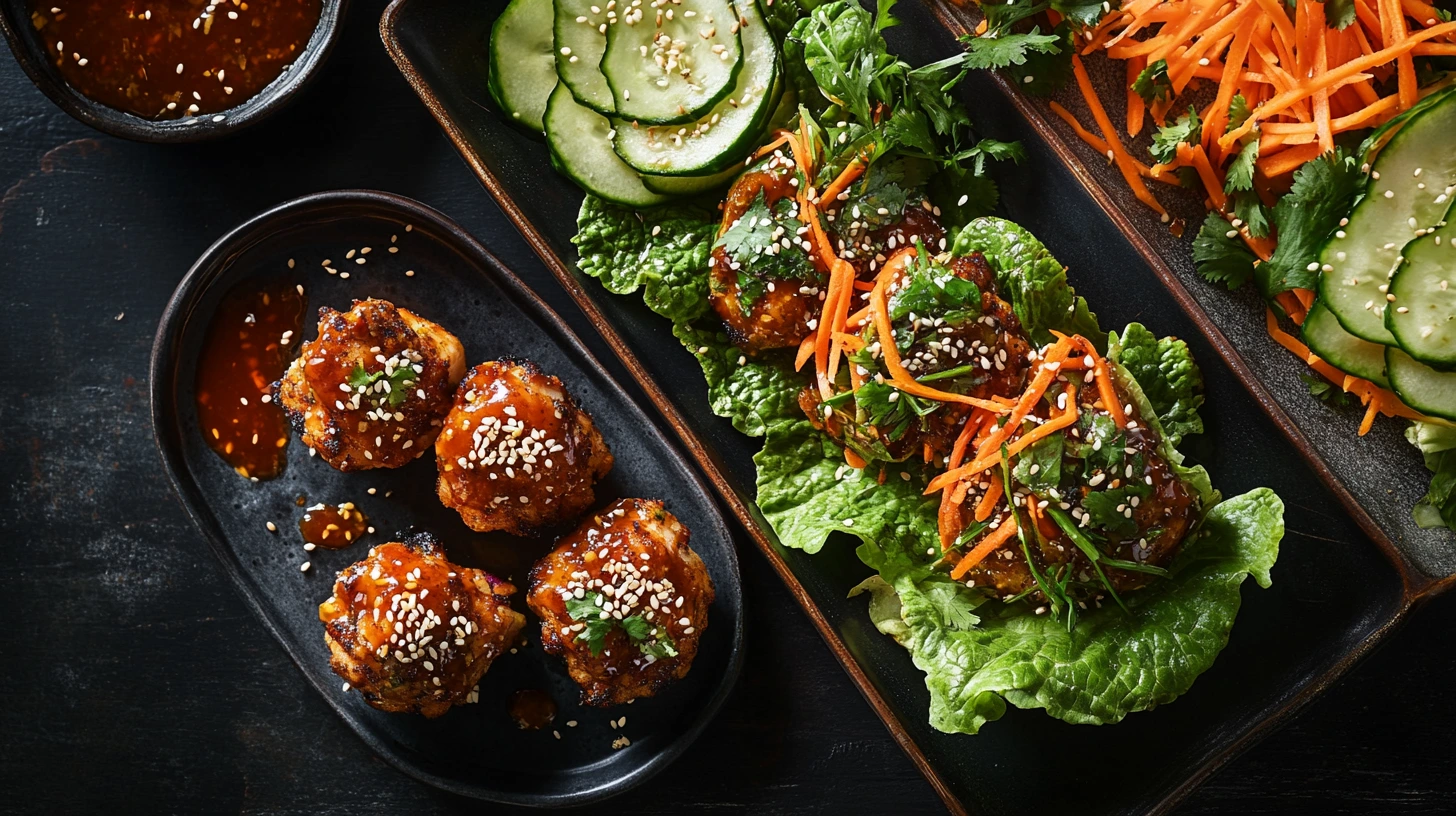Thai Chicken Bites are small in size but big on flavor. They’re crispy, juicy, and full of the bold tastes that make Thai food so popular—sweet, spicy, salty, and tangy all in one bite. These bites are perfect as appetizers, party snacks, or even quick meals.
They’re also super easy to make at home. With a few simple ingredients like chicken, garlic, chili, and lemongrass, you can create a dish that feels like it came straight from a Thai street food stall.
In this article, you’ll learn everything about Thai Chicken Bites—from their ingredients and origins to how to cook them and serve them in fun and tasty ways. Whether you love Thai food or you’re trying it for the first time, this guide will help you enjoy one of Thailand’s most delicious and versatile dishes.
Let’s get started!🍗🇹🇭🔥😋🥢
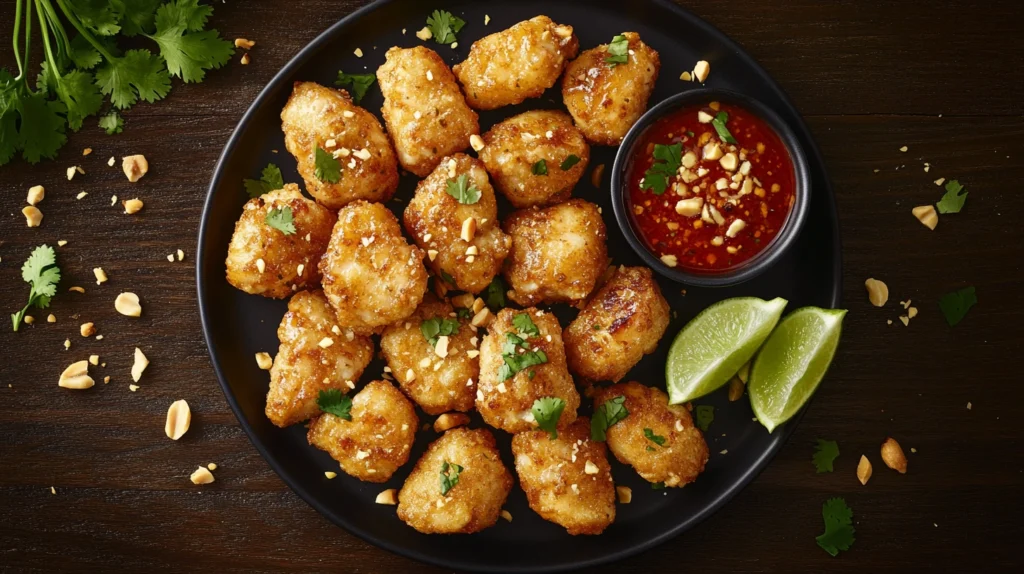
The Origins of Thai Chicken Bites

Thai Cuisine’s Flavor Philosophy
In Thailand, food is more than sustenance—it’s a way of life. Meals are meant to be shared, and variety is everything. Even the smallest dishes pack huge flavor, a trait clearly seen in Thai Chicken Bites. The intricate layers of flavor come from foundational Thai ingredients like lemongrass, fish sauce, garlic, chili, and palm sugar, which have been used in Thai cooking for centuries.
These ingredients, when combined with a protein like chicken, create a dish that’s both aromatic and satisfying. It’s this mastery of balance and depth that turns even a simple chicken bite into a culinary experience.
These bites echo the bold flavors found in other dishes featured on DiverseRecipe, like the collection of Asian food recipes that showcase everything from curries to noodle bowls. If you’re exploring Thai food for the first time, that’s a great companion read.
Street Food Culture in Thailand
To understand Thai Chicken Bites, you must step into the bustling streets of Bangkok or Chiang Mai. Street food vendors are the heart of Thai culinary culture. You’ll find everything from skewered meats and sizzling noodles to coconut desserts and grilled seafood—all cooked on the spot and served hot.
Thai Chicken Bites likely evolved as a portable, quick-to-cook street snack that locals could enjoy on the go. They’re small enough to eat without utensils, but flavorful enough to feel like a complete dish. The bite-sized portions, bold marinades, and easy-to-dip shapes make them perfect for Thailand’s energetic street food scene.
It’s this very portability and flavor punch that helped Thai Chicken Bites transition from food carts to home kitchens and upscale restaurants across the globe.
Craving a light, comforting dish next? Pair your bites with a warm bowl of Easy Pea Soup for a fun fusion dinner that balances spice with creamy comfort.
How Thai Chicken Bites Emerged
Though not always called “Thai Chicken Bites” in Thailand, similar dishes have existed in Thai cuisine for decades.
As global fusion cuisine began to rise in popularity, chefs outside of Thailand started adapting these traditional recipes into more accessible forms. Enter Thai Chicken Bites: crispy, juicy, and flavored with classic Thai spices but reimagined as a universally loved appetizer.
In Western kitchens, the dish was rebranded with trendy terms like “bites” or “nuggets,” yet the heart of the dish remained authentically Thai. Today, Thai Chicken Bites are a staple on menus from food trucks to Michelin-starred establishments, all thanks to their rich history and flavor-packed profile.
These bites may be small, but their cultural roots and flavor depth are anything but. Now that we’ve explored where they come from, it’s time to take a closer look at what makes up these delicious morsels.
Key Ingredients in Thai Chicken Bites
Creating Thai Chicken Bites that burst with flavor starts with understanding the essential ingredients that define their taste. Each component plays a key role in building the signature layers of sweet, salty, tangy, and spicy that Thai cuisine is known for. Whether you’re preparing these bites from scratch or analyzing what makes them so delicious, here’s a deep dive into the core elements.
The Role of Lemongrass and Kaffir Lime
Lemongrass and kaffir lime leaves are staples in Thai cooking, and their inclusion in Thai Chicken Bites is what gives the dish its citrusy, aromatic edge. Lemongrass, a stalky herb with a lemon-mint flavor, is often finely chopped or crushed to release its oils, infusing the chicken with a refreshing brightness.
Kaffir lime leaves, on the other hand, bring a more intense citrus scent, almost floral in nature. When minced or blended into the marinade, these leaves elevate the entire dish, providing a distinct Thai aroma that sets it apart from other chicken appetizers.
These ingredients don’t just offer fragrance—they also help tenderize the chicken during the marination process, ensuring each bite remains juicy and flavorful.
Protein Choice – Chicken Cuts that Work Best
While you can technically use any part of the chicken, boneless, skinless chicken thighs are the gold standard for Thai Chicken Bites. The thighs soak up the marinade beautifully, and they stay moist even after frying or baking.
If you’re looking for a leaner option, chicken breast can be used, but it requires careful marination and quicker cooking times to avoid drying out. Some chefs even mix both cuts to strike a balance between tenderness and leanness.
The meat is typically cut into small, even chunks—ideal for quick cooking and uniform coating in sauces or batters.
The Sweet-Spicy Balance in Thai Sauces
One of the most iconic aspects of Thai Chicken Bites is the sauce—either used as a glaze or as a side dip. Thai cuisine thrives on contrasts, and this is where the magic happens.
Here are a few common elements:
- Fish Sauce: Adds a deep umami flavor and saltiness.
- Soy Sauce: Often combined with fish sauce for added richness.
- Palm Sugar or Brown Sugar: Delivers the sweet counterpoint to the heat and saltiness.
- Chili Paste or Fresh Thai Chilies: Introduces the spice, which can range from mild to fiery.
- Garlic and Ginger: Build an aromatic base that rounds out the flavor.
- Tamarind Paste or Lime Juice: Adds acidity and brightness, balancing the sweetness.
These sauces can be brushed on after cooking, used as a marinade, or served alongside the finished bites. The combination is customizable, making the dish versatile for various spice levels and preferences.
Optional Add-Ins for Extra Flavor
Want to take things up a notch? Consider these optional ingredients:
- Coconut Milk: For a richer marinade with creamy undertones.
- Crushed Peanuts: Add texture and nutty flavor.
- Sesame Seeds: Sprinkled on top for visual appeal and a light crunch.
Each of these additions can tailor the Thai Chicken Bites to your personal taste or the theme of your meal.
With the right ingredients in hand, you’re halfway to mastering Thai Chicken Bites. But knowing how to prepare and cook them is just as important. Up next, we’ll cover exactly how to make them at home with pro tips and techniques.
If you’re looking for an alternative cooking adventure, try something warm and satisfying like Asparagus Risotto—it’s a great next-day meal with leftover Thai chicken on top!
How to Make Authentic Thai Chicken Bites at Home
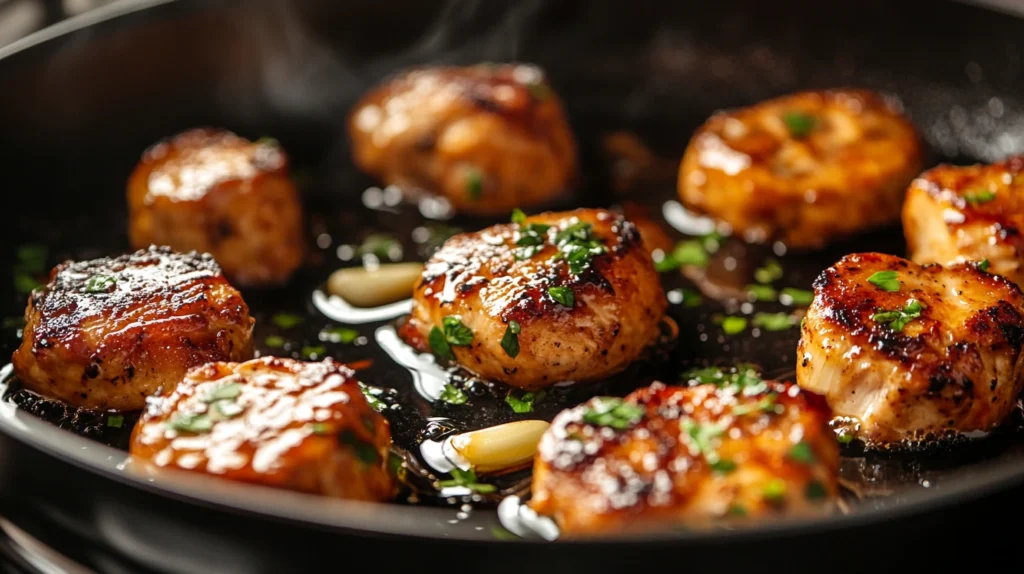
Crafting the perfect Thai Chicken Bites in your own kitchen is absolutely doable—even if you’ve never cooked Thai food before. With a few essential ingredients and a simple process, you can create a restaurant-quality appetizer that bursts with flavor. Let’s break down the step-by-step preparation, best marination practices, and the most effective cooking methods to help you nail this dish every single time.
Step-by-Step Preparation Guide
Here’s a straightforward recipe to help you get started:
Ingredients:
- 500g boneless, skinless chicken thighs (cut into bite-sized pieces)
- 2 tablespoons fish sauce
- 1 tablespoon soy sauce
- 1 tablespoon palm sugar or brown sugar
- 1 teaspoon grated ginger
- 2 cloves garlic, minced
- 1 stalk lemongrass (white part only, finely chopped)
- 4 kaffir lime leaves, minced
- 1 teaspoon chili paste (adjust to taste)
- 1 tablespoon lime juice
- 1 tablespoon cornstarch (optional for extra crispiness)
- Oil for frying or baking
Instructions:
- Mix the Marinade: In a large bowl, combine fish sauce, soy sauce, sugar, garlic, ginger, lemongrass, kaffir lime leaves, chili paste, and lime juice.
- Marinate the Chicken: Add the chicken pieces and toss well.
- Coat (Optional): If you want extra crispiness, toss the marinated chicken in a light coating of cornstarch before cooking.
- Cook: Choose your cooking method—pan-fry, bake, or air-fry.
- Serve: Once golden brown and cooked through, serve with your favorite Thai dipping sauce.
Marination Techniques for Maximum Flavor
Why is marination important? Thai Chicken Bites are only as flavorful as the time and care you put into the marinade. The acids (lime juice or tamarind) tenderize the meat, while the umami-rich elements (fish sauce and soy sauce) soak deep into the chicken.
Tips for better marination:
- Cut chicken uniformly for even flavor distribution.
- Use a zip-lock bag to ensure the chicken is fully coated and packed tightly.
- Refrigerate for at least 1 hour but aim for overnight marination if time allows.
The longer the marination, the deeper the flavor!
Cooking Methods – Pan-Fried, Baked, or Air-Fried?
You’ve got options when it comes to cooking Thai Chicken Bites, and each method has its perks.
Pan-Fried (Most Traditional)
- Pros: Crispy outside, juicy inside, and quick cooking.
- How to: Heat oil in a pan over medium-high heat.
- Tip: Don’t overcrowd the pan. That causes steaming instead of crisping.
Baked (Healthier Option)
- Pros: Less oil, hands-free cooking, and evenly cooked bites.
- How to: Preheat oven to 200°C (400°F). Arrange chicken bites in a single layer. Bake for 18–22 minutes, flipping halfway.
- Tip: Brush or spray with oil to promote browning and crisp texture.
Air-Fried (Modern Favorite)
- Pros: Crispy results with minimal oil.
- How to: Set air fryer to 190°C (375°F). Cook for 10–12 minutes, shaking halfway through.
- Tip: Avoid overcrowding the basket. Cook in batches if needed.
No matter which method you choose, aim for an internal temperature of 75°C (165°F) to ensure the chicken is safely cooked while remaining juicy.
Optional Final Touches
Once cooked, give your Thai Chicken Bites an extra boost by:
- Drizzling with sweet chili sauce or spicy peanut sauce
- Garnishing with chopped cilantro or green onions
- Sprinkling with crushed peanuts or sesame seeds
These finishing touches enhance both flavor and presentation, turning your dish into a crowd-pleaser.
With this guide, you’ve now got everything you need to create Thai Chicken Bites at home with confidence. But why stop there? In the next section, we’ll explore creative variations and fusion ideas to keep things exciting.
Variations and Fusion Ideas
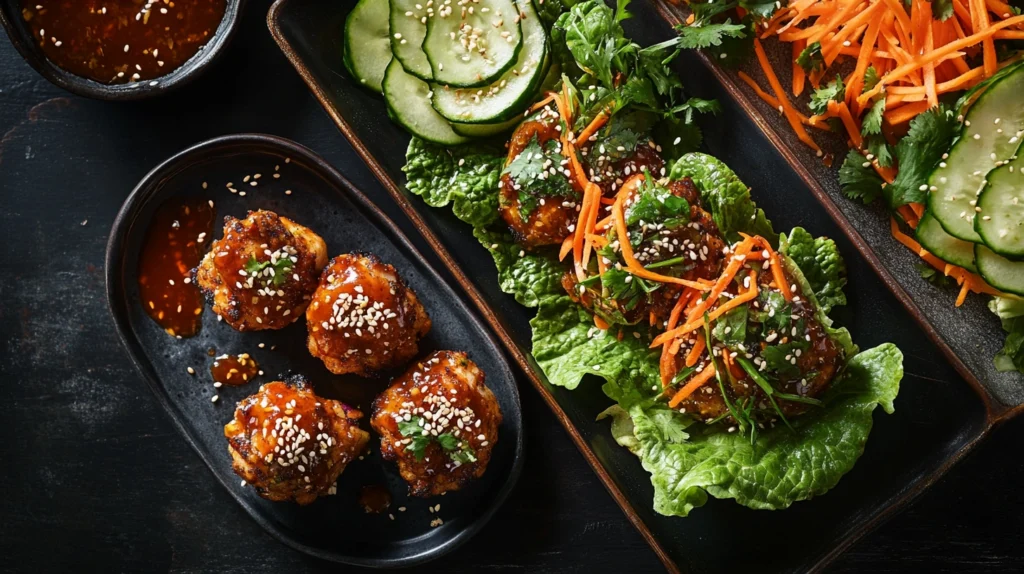
One of the most exciting things about Thai Chicken Bites is their incredible versatility. While the classic version is mouthwateringly good, you can easily switch up the flavors, textures, and presentation styles to match different occasions, dietary preferences, or simply to explore new tastes. Let’s dig into some of the most delicious and creative ways to reinvent Thai Chicken Bites while keeping that signature Thai essence alive.
Thai Chicken Bites with Peanut Sauce
A timeless Thai classic is the combo of chicken and peanut sauce—rich, nutty, and packed with umami. To create this variation, simply drizzle or serve your Thai Chicken Bites with a creamy homemade or store-bought peanut dipping sauce.
Peanut Sauce Ingredients:
- 1/2 cup peanut butter (smooth or chunky)
- 1 tbsp soy sauce
- 1 tbsp fish sauce
- 1 tbsp brown sugar
- 1 tsp grated ginger
- Juice of half a lime
- Water to thin to your desired consistency
How to Use:
- Toss the cooked chicken bites in the sauce like a glaze.
- Serve on the side for dipping.
This variation is ideal for serving as party snacks, satay-style skewers, or over a bed of jasmine rice.
Sweet Chili Glazed Thai Chicken Bites
Glaze your cooked Thai Chicken Bites with Thai sweet chili sauce. It’s readily available in most supermarkets and adds a glossy finish and bold flavor that’s universally loved.
This variation is perfect for game day snacks, holiday platters, or even bento boxes.
Thai Chicken Sliders and Wraps
If you want to turn your appetizer into a meal, transform Thai Chicken Bites into sliders or wraps! These fun, hand-held options are perfect for picnics, parties, and lunchboxes.
Thai Chicken Sliders
- Use mini brioche buns or dinner rolls.
- Add a few chicken bites per bun.
- Top with pickled veggies, fresh cilantro, and a smear of spicy mayo or peanut sauce.
Thai Chicken Lettuce Wraps
- Wrap cooked chicken bites in large butter lettuce leaves.
- Add thinly sliced cucumber, carrots, and fresh herbs like mint or Thai basil.
- Finish with a drizzle of tangy lime vinaigrette or hoisin sauce.
These options turn Thai Chicken Bites into the center of a filling, fresh, and flavorful meal.
Vegan or Vegetarian “Thai Bites” Alternatives
If you’re cooking for a plant-based audience, you can replicate the flavor and texture of Thai Chicken Bites with meat-free alternatives. Try these options:
- Tofu Bites: Use extra-firm tofu, marinated in the same Thai spices, and pan-fry until golden.
- Cauliflower Bites: Roast or air-fry bite-sized cauliflower florets with a Thai marinade for a spicy-sweet vegetarian take.
- Plant-Based Chicken Alternatives: Many soy- or pea-based chicken substitutes now mimic texture remarkably well. Simply swap them in and follow the same recipe.
The bold Thai flavors ensure that even non-meat versions still satisfy.
International Fusion Flavors
Want to blend cultures? These fusion concepts combine Thai Chicken Bites with elements of other cuisines:
- Tex-Mex Thai Tacos: Use small tortillas and fill them with chicken bites, slaw, and chili-lime crema.
- Mediterranean-Thai Bowl: Serve Thai Chicken Bites over couscous with tzatziki and grilled vegetables.
The possibilities are endless when you start mixing global influences with Thai flavors.
Whether you’re sticking with tradition or branching out with new twists, Thai Chicken Bites are incredibly adaptable. In the next part, we’ll dive into nutrition, dietary options, and how to make these bites work for your health goals.
Nutritional Benefits and Considerations
Thai Chicken Bites aren’t just tasty—they can also be a healthy, high-protein option when made with the right ingredients. Whether you want to eat clean, avoid certain allergens, or follow a special diet, these bites can easily fit into your lifestyle. Here’s how!
Protein-Packed and Low-Carb
One of the most appealing nutritional benefits of Thai Chicken Bites is their high protein content. Made primarily from chicken thighs or breast, they deliver around 25–30 grams of protein per serving, depending on the size of the portion and preparation method. This makes them ideal for:
- Post-workout meals
- Muscle-building diets
- Keto and low-carb plans
By skipping heavy breading or sugar-laden sauces, you can easily turn this dish into a low-carb, high-protein powerhouse. Especially when baked or air-fried, Thai Chicken Bites can become a guilt-free snack or main dish that supports your nutritional goals.
Nutrition Breakdown (approx. per 100g of cooked chicken bites):
- Calories: 190–220 kcal
- Protein: 26g
- Fat: 8–10g (depending on cut and cooking method)
- Carbs: 4–6g (mainly from marinade/sauce)
- Fiber: 0–1g
Gluten-Free Options
Thai Chicken Bites are naturally gluten-free—if you use the right ingredients. Some traditional Thai sauces contain soy sauce or other additives that include wheat. But with just a few mindful substitutions, they become completely safe for gluten-sensitive individuals.
Tips for Gluten-Free Preparation:
- Check that your fish sauce is gluten-free (some brands add starches).
- Avoid pre-made marinades unless clearly labeled “gluten-free.”
By using fresh ingredients and reading labels carefully, you can easily keep your dish 100% gluten-free without compromising flavor.
Allergen Warnings (Peanuts, Soy, etc.)
While Thai Chicken Bites are generally allergy-friendly, they can pose a risk if you’re not careful with certain common allergens:
1. Peanuts
- Thai recipes often include peanut sauce or crushed peanuts.
- For those with allergies, swap with almond butter, sunflower seed butter, or tahini.
2. Soy
- Soy sauce and some marinades contain soy protein.
- Replace with coconut aminos or liquid aminos for a soy-free alternative.
3. Fish & Shellfish
- Fish sauce is a major component of Thai flavor profiles.
- If allergic, consider using vegan fish sauce alternatives made from seaweed and mushrooms.
4. Chilies
- Thai food is known for its heat. Always ask or label accordingly for those sensitive to spice.
Being transparent with ingredients, especially when serving others, is crucial. Thai Chicken Bites can be easily adapted for most dietary restrictions, making them an inclusive choice for gatherings.
Clean Eating and Paleo-Friendly Versions
For clean eaters and those following Paleo, Whole30, or anti-inflammatory diets, Thai Chicken Bites can be a go-to protein option when prepared with wholesome ingredients:
Paleo-Friendly Substitutions:
- Use coconut aminos instead of soy sauce.
- Sweeten with honey or pure maple syrup instead of refined sugars.
Whole30 Tips:
- Avoid all forms of added sugar and grains.
- Stick to whole foods like herbs, spices, citrus juice, and compliant sauces.
Thai Chicken Bites prepared this way are not only flavorful but nourishing for your gut and body.
Kid-Friendly and Family Meal Adaptations
Thai Chicken Bites aren’t just for adults. If you use less spice and serve them with mild sauces like honey garlic or sweet soy, kids and picky eaters will enjoy them too.
Kid-Friendly Tips:
- Skip the chili paste.
- Serve with ketchup, mild peanut sauce, or honey mustard.
- Add to wraps, skewers, or rice bowls for variety.
Making healthy food exciting for kids is a win—and Thai Chicken Bites deliver on both taste and fun.
With this final section, you now know how Thai Chicken Bites can be a flavor-packed yet flexible part of your diet. From gluten-free tweaks to protein-powered meal prep, these little bites deliver big benefits.
Frequently Asked Questions
What are the spices in Thai fried chicken?
Thai fried chicken (and Thai Chicken Bites) are known for their vibrant and aromatic spice blend. Common spices and herbs used include:
- Garlic – Provides a savory, aromatic base.
- Coriander root or powder – Adds an earthy, citrusy note.
- White or black pepper – For subtle heat and spice.
- Chili flakes or paste – Brings the signature Thai kick.
- Turmeric (optional) – Sometimes used for color and an earthy flavor.
- Lemongrass and kaffir lime leaves – Infuse freshness and complexity.
These ingredients are typically combined in a marinade, giving the chicken its deep flavor before it’s fried to golden perfection.
How many calories are in Thai chicken bites?
The calorie count for Thai Chicken Bites can vary based on cooking method and sauce used, but here’s a general estimate:
- Pan-Fried or Air-Fried (with light oil): 190–220 kcal per 100g serving.
- Deep-Fried: Up to 250–300 kcal per 100g serving due to oil absorption.
- Baked (healthiest): Around 180–200 kcal per 100g.
Keep in mind that sauces like sweet chili or peanut sauce can add an extra 50–100 calories per tablespoon. For a lighter version, bake or air-fry and use dipping sauces sparingly.
How to make crispy chicken Thai style?
To make authentic crispy Thai-style chicken, follow these key steps:
- Marinate deeply with ingredients like fish sauce, garlic, lemongrass, and sugar for flavor infusion.
- Coat the chicken in rice flour, cornstarch, or tapioca starch—these yield a crispier crust than regular flour.
- Fry at the right temperature (around 175°C/350°F) to lock in moisture and crisp up the outside.
- Double-frying technique (fry once at low temp, rest, then fry again hotter) can enhance crunchiness.
- Rest on a rack after frying to keep the exterior dry and crispy.
Bonus tip: Add a touch of baking powder to the coating mixture for a lighter, bubbly crisp.
What is Thai chicken made of?
Thai chicken dishes—including Thai Chicken Bites—are typically made with:
- Chicken thighs or breast – Thighs are preferred for tenderness and flavor.
- Marinade base – Fish sauce, soy sauce, garlic, lemongrass, palm sugar, and lime juice.
- Sauces (optional) – Sweet chili, peanut, or tamarind-based sauces for extra flavor.
The result is a well-balanced dish that combines savory, sweet, spicy, and sour elements—hallmarks of Thai cuisine.
What goes with Thai fried chicken?
Thai fried chicken pairs beautifully with a wide range of sides and accompaniments, including:
- Sticky rice or jasmine rice – Classic Thai staples.
- Papaya salad (Som Tum) – Adds crunch and a tangy counterpoint.
- Sweet chili sauce or peanut dipping sauce – Must-haves for dipping.
- Pickled vegetables – Cut through the richness.
- Cucumber salad – Refreshing and cooling.
These combinations create a complete, satisfying Thai meal.
What do you eat with fried chicken bites?
Thai Chicken Bites can be enjoyed in many different ways! Here are a few great pairings:
- Rice or noodles – For a hearty meal.
- Lettuce wraps – For a low-carb option.
- Thai slaw or salad – Offers a crisp, fresh contrast.
- Steamed or stir-fried vegetables – To keep things balanced and nutritious.
- Mini slider buns or wraps – For fusion-style snacks or party food.
These bites are also fantastic on their own with dipping sauce—ideal for parties, game nights, or even lunchboxes!
Conclusion
Thai Chicken Bites are a tasty, easy-to-make dish that brings the bold and exciting flavors of Thailand right to your kitchen. Whether you enjoy them as a snack, party appetizer, or quick meal, they’re sure to be a hit with family and friends.
With just a few simple ingredients and steps, you can make these crispy, juicy bites at home. Plus, they’re easy to customize with different sauces, sides, and even healthy options.
Now that you know how to make and enjoy Thai Chicken Bites, it’s time to give them a try. You’ll be surprised how much flavor you can pack into each bite!🍗🔥
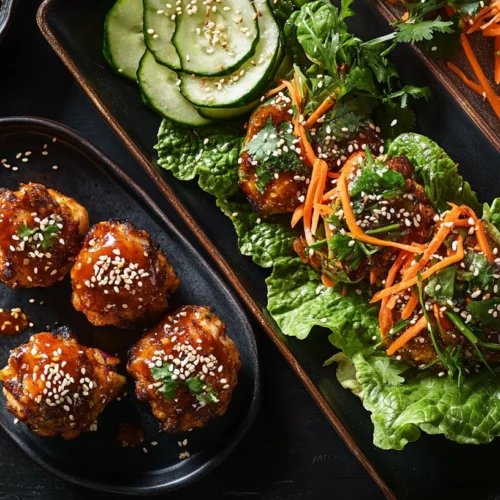
Thai Chicken Bites
Equipment
- Mixing bowl
- Chopping board and knife
- Grater or mortar and pestle (for herbs)
- Frying pan or air fryer
- Tongs or spatula
- Paper towels (for draining)
Ingredients
- For the Chicken Marinade:
- 500 g boneless skinless chicken thighs (cut into bite-sized pieces)
- 2 tablespoons fish sauce
- 1 tablespoon soy sauce
- 1 tablespoon brown sugar or palm sugar
- 2 cloves garlic minced
- 1 tablespoon lemongrass finely chopped
- 1 teaspoon ginger grated
- 2 kaffir lime leaves finely sliced
- Juice of 1/2 lime
- 1 teaspoon chili paste or crushed red pepper adjust to taste
- For Frying Optional:
- 2 tablespoons cornstarch for coating
- Oil for frying vegetable or peanut oil
- For Garnish:
- Chopped cilantro
- Lime wedges
- Sweet chili sauce or peanut sauce optional for dipping
Instructions
- Marinate the Chicken:
- In a large bowl, combine fish sauce, soy sauce, sugar, garlic, lemongrass, ginger, kaffir lime leaves, lime juice, and chili. Add the chicken and toss well. Cover and refrigerate for at least 1 hour (preferably overnight).
- Optional Coating:
- If you want them extra crispy, toss the marinated chicken in cornstarch before cooking.
- Cook the Chicken:
- Pan-Fry Method: Heat oil in a pan over medium-high heat. Fry the chicken pieces for 3–4 minutes per side until golden and fully cooked.
- Air-Fry Method: Preheat air fryer to 190°C (375°F). Spray chicken with oil and air-fry for 10–12 minutes, shaking halfway.
- Drain & Serve:
- Transfer the cooked chicken to paper towels to drain excess oil. Serve hot with dipping sauce and garnishes.

